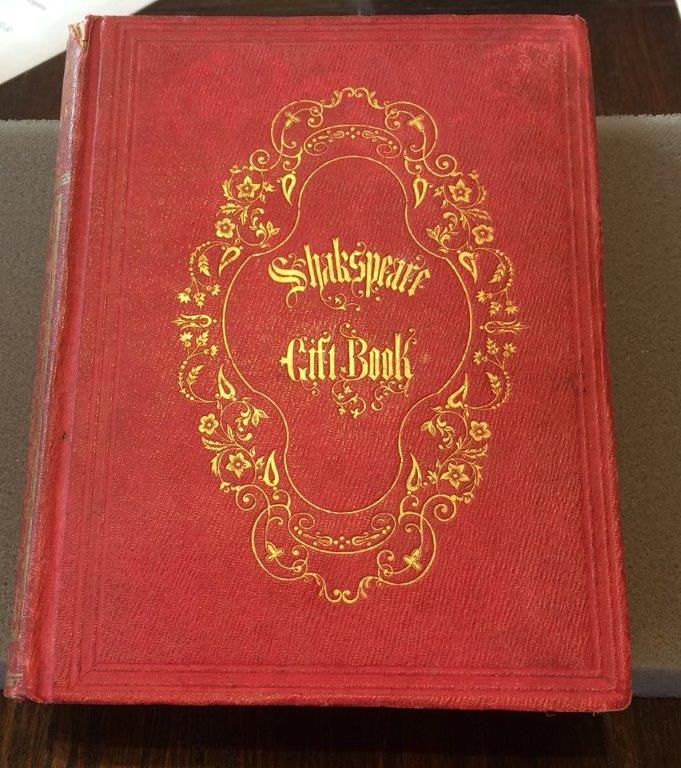The Girlhood of Shakespeare's Heroines
The book in question is the second series of The Girlhood of Shakespeare's Heroines: in a series of fifteen tales written by Mary Cowden Clarke. It was published by G.P. Putnam in New York at 155 Broadway in 1852. This copy of the book was given as a gift to Cecila Chardon by her friend Eliza on “Jany 27, 1855”. The book was designed to be given as a gift, as evidenced by the title on the covers, which are clearly labeled “Shakespeare Gift Book,” in gold lettering. It was probably a gift suitable for a young, learned woman, judging by the ownership of the item. Within the book, lays an “honor stamp” placed by LSU; the librarians of Hill Memorial indicated that it has been in the special collections library for more than forty years. The length is 7 ½ inches while the width is 6 inches. The cover of the book is wrapped in a blood-red cloth and bounded by the publisher’s company, evidenced by the stamp of the publisher’s last name on the spine of the book. Since the binding is by the publisher, this book was most likely sold at a book store. Also, there is a page in the book that was not properly cut as there is text printed over the folded page, which protrudes from the rest of the pages when stretched out. This is indicative of an error by the publisher during the binding process of the book. The borders of the covers as well as the designs on the spine are filled in with gold coloring. The edges of the pages are golden-trimmed, but the color has faded and lost its luster. They are also thick, stiff, and stained by mildew; perhaps the pages were splashed on by water or kept within a humid environment. However, there are some pages that are not covered by mildew but are only brown-tinged due to aging. One can find engraved drawings prior to the stories of the heroines, each containing a scene or character pertinent to the story. There are five stories containing seven protagonists: Isabella, Katharina and Bianca, Ophelia, Rosalind and Celia, and Juliet. However, one of the drawings seems to be absent from the book, as the story of Juliet has no such illustration, despite a marking left in the book, which looks to be an outline the precise shape as the rest of the illustrations.

The object that our group creatively interpreted was a book titled The Girlhood of Shakespeare’s Heroines. The book contains several stories regarding various heroines from Shakespeare’s works. In order to best represent the book as a whole, we decided to focus on a specific section. For this section, we chose to focus on Ophelia, since she is a character whom many people recognize from her role in the Shakespearean play Hamlet, as well as a character with which our group was familiar. In order to represent Ophelia, we felt that creatively framing a portrait of the character would best represent her character from the story. The portrait was found on the website, Tumblr, and was chosen for many reasons. One important factor was its ornate nature, which showcased the character as a young woman in black-and-white color allowing it both to appear older and to make the character stand out from the fervent color of life surrounding her. We chose to use watercolor background for the portrait, as one of our members was skilled with the medium. The colors represent the vivid colors of life, which contrast her portrait’s somber black-and-white coloring. We framed the portrait with rose petals, as the character is frequently compared to a rose’s beauty throughout her story. The red rose represents Ophelia’s character in many instances throughout the book. In fact, roses were such a noteworthy flower in the heroine’s story that her chapter within the book is entitled, “The Rose of Elsinore.” With the vibrant pinks and purples of the background and the use of rose petals, this medium displays the tragic reality of Ophelia’s life. As Ophelia’s character blossoms like a beautiful rose, she continually faces the tragic circumstances of her life, eventually causing her to fade away from the beautiful colors permeating her life.
Works Cited
Simmons, Jean. "SimplySassy." SimplySassy. Tumblr, Web. 10 Apr. 2016.